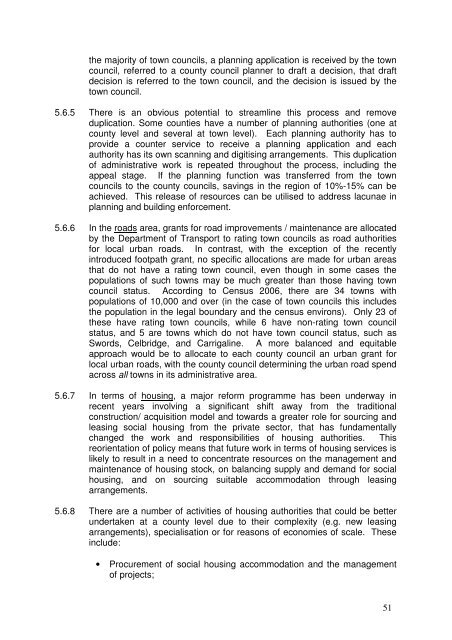Report of the Local Government Efficiency Review Group
Report of the Local Government Efficiency Review Group
Report of the Local Government Efficiency Review Group
Create successful ePaper yourself
Turn your PDF publications into a flip-book with our unique Google optimized e-Paper software.
<strong>the</strong> majority <strong>of</strong> town councils, a planning application is received by <strong>the</strong> town<br />
council, referred to a county council planner to draft a decision, that draft<br />
decision is referred to <strong>the</strong> town council, and <strong>the</strong> decision is issued by <strong>the</strong><br />
town council.<br />
5.6.5 There is an obvious potential to streamline this process and remove<br />
duplication. Some counties have a number <strong>of</strong> planning authorities (one at<br />
county level and several at town level). Each planning authority has to<br />
provide a counter service to receive a planning application and each<br />
authority has its own scanning and digitising arrangements. This duplication<br />
<strong>of</strong> administrative work is repeated throughout <strong>the</strong> process, including <strong>the</strong><br />
appeal stage. If <strong>the</strong> planning function was transferred from <strong>the</strong> town<br />
councils to <strong>the</strong> county councils, savings in <strong>the</strong> region <strong>of</strong> 10%-15% can be<br />
achieved. This release <strong>of</strong> resources can be utilised to address lacunae in<br />
planning and building enforcement.<br />
5.6.6 In <strong>the</strong> roads area, grants for road improvements / maintenance are allocated<br />
by <strong>the</strong> Department <strong>of</strong> Transport to rating town councils as road authorities<br />
for local urban roads. In contrast, with <strong>the</strong> exception <strong>of</strong> <strong>the</strong> recently<br />
introduced footpath grant, no specific allocations are made for urban areas<br />
that do not have a rating town council, even though in some cases <strong>the</strong><br />
populations <strong>of</strong> such towns may be much greater than those having town<br />
council status. According to Census 2006, <strong>the</strong>re are 34 towns with<br />
populations <strong>of</strong> 10,000 and over (in <strong>the</strong> case <strong>of</strong> town councils this includes<br />
<strong>the</strong> population in <strong>the</strong> legal boundary and <strong>the</strong> census environs). Only 23 <strong>of</strong><br />
<strong>the</strong>se have rating town councils, while 6 have non-rating town council<br />
status, and 5 are towns which do not have town council status, such as<br />
Swords, Celbridge, and Carrigaline. A more balanced and equitable<br />
approach would be to allocate to each county council an urban grant for<br />
local urban roads, with <strong>the</strong> county council determining <strong>the</strong> urban road spend<br />
across all towns in its administrative area.<br />
5.6.7 In terms <strong>of</strong> housing, a major reform programme has been underway in<br />
recent years involving a significant shift away from <strong>the</strong> traditional<br />
construction/ acquisition model and towards a greater role for sourcing and<br />
leasing social housing from <strong>the</strong> private sector, that has fundamentally<br />
changed <strong>the</strong> work and responsibilities <strong>of</strong> housing authorities. This<br />
reorientation <strong>of</strong> policy means that future work in terms <strong>of</strong> housing services is<br />
likely to result in a need to concentrate resources on <strong>the</strong> management and<br />
maintenance <strong>of</strong> housing stock, on balancing supply and demand for social<br />
housing, and on sourcing suitable accommodation through leasing<br />
arrangements.<br />
5.6.8 There are a number <strong>of</strong> activities <strong>of</strong> housing authorities that could be better<br />
undertaken at a county level due to <strong>the</strong>ir complexity (e.g. new leasing<br />
arrangements), specialisation or for reasons <strong>of</strong> economies <strong>of</strong> scale. These<br />
include:<br />
• Procurement <strong>of</strong> social housing accommodation and <strong>the</strong> management<br />
<strong>of</strong> projects;<br />
51
















